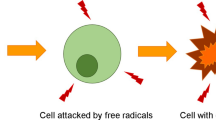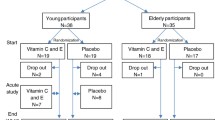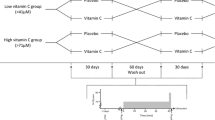Summary
Even though vitamin E may not improve physical achievements in sports competitions, as shown in several swimming experiments, it is important for the health of skeletal muscle: in its role as the major lipid-soluble chainbreaking antioxidant in lipid cell membranes, vitamin E protects muscle tissue in aerobic exercise, in which oxygen metabolism and, consequently, free radical production are greatly accelerated. Animal studies in several laboratories have shown that endurance exercise results in the same type of oxidative muscle damage as does vitamin E deficiency: there is an increase in the peroxidation products pentance and malondialdehyde and in enzymes leaked from muscles to plasma. Oxidative tissue damage in vitamin-Edeficient animals is exacerbated by endurance training and, conversely, it is reduced by high-dose vitamin E supplementation; also, preliminary studies in humans have demonstrated antioxidant protection by high-dose vitamin E supplementation. After endurance exercise leakage of enzymes into the plasma and output of pentane in the breath were significantly reduced. During a high-altitude expedition in the Himalayas, protection was shown to be significantly better in the supplemented group than in the placebo group, as determined by anaerobic threshold and pentane exhalation.
Zusammenfassung
Ältere Studien haben gezeigt, daß Vitamin E die sportliche Leistungsfähigkeit bei Schwimmern nicht zu steigern vermag. Trotzdem ist das Vitamin für die Skelettmuskulatur der Sportler wichtig: Als das bedeutendste lipidlösliche Antioxidans in Zellmembranen schützt Vitamin E das Muskelgewebe bei aeroben physischen Belastungen, bei denen der Energiestoffwechsel stark beschleunigt ist, vor übermäßiger Peroxidation von ungesättigten Fettsäuren in Zellmembranen. In verschiedenen Labors führte Ausdauertraining von Versuchstieren zu denselben oxidativen Muskelschädigungen wie Vitamin-E-Mangel: Die Peroxidationsprodukte Pentan und Malondialdehyd waren erhöht, und Muskelenzyme waren vermehrt ins Plasma gelangt. Bei Tieren mit Vitamin-E-Mangel werden die Muskelschäden durch Ausdauertraining verstärkt, während sie durch Vitamin-E-Supplementierung vermindert werden. Präliminäre Studien am Menschen weisen ebenfalls auf eine antioxidative Schutzwirkung von Vitamin E gegen Muskelschädigung hin. Das zeigt sich in reduzierter Bildung von Pentan und in vermindertem Übertritt von Muskelenzymen ins Plasma nach Ausdauertraining. Bei einer Expedition von Bergsteigern ins Himalajagebiet stellten die Autoren ebenfalls eine signifikante Schutzwirkung von Vitamin-E-Supplementierung fest. Diese äußerte sich in einer erhöhten anaeroben Schwelle und in reduzierter Pentankonzentration im Atem bei Belastung.
Similar content being viewed by others
References
Machlin LJ, Bendich A (1987) Free radical tissue damage: protective role of antioxidant nutrients. FASEB J 1:441–445
McCoy PB, King MM (1980) Vitamin E: its role as a biologic free radical scavenger and its relationship to the microsomal mixed function oxidase system. In: Machlin LJ (ed) Vitamin E. A Comprehensive Treatise. Marcel Dekker, New York Basel, pp 289–317
Burton GW, Joyce A, Ingold KU (1983) Is vitamin E the only lipid-soluble, chain-breaking antioxidant in human blood plasma and erythrocyte membranes? Arch Biochem Biophys 221:281–290
Cureton TK (1954) Effect of wheat germ oil and vitamin E on normal human subjects in physical training programs. Am J Physiol 179:628
Nelson JS (1980) Pathology of vitamin E deficiency. In: Machlin LJ (ed) Vitamin E. A Comprehensive Treatise. Marcel Dekker, New York Basel, pp 397–428
Sharman IM, Down MG, Sen RN (1971) The effects of vitamin E and training on physiological function and athletic performance in adolescent swimmers. Br J Nutr 26:265–276
Sharman IM, Down MG, Norgan NG (1976) The effects of vitamin E on physiological function and athletic performance of trained swimmers. J Sports Med 16:215–225
Shephard RJ, Campbell R, Pimm P, Stuart D, Wright GR (1974) Vitamin E, exercise, and the recovery from physical activity. Eur J Appl Physiol 33:119–126
Lawrence JD, Bower RC, Riehl WP, Smith JL (1975) Effects of α-tocopherol acetate on the swimming endurance of trained swimmers. Am J Clin Nutr 28:205–208
Packer L (1988) Oxygen radicals and antioxidants in endurance exercise. In: Benzi G, Packer L, Siliprandi N (eds) Biochemical Aspects of Physical Exercise. Elsevier, Amsterdam, pp 73–92
Jackson MJ (1990) Free radicals and skeletal mucle disorders. In: Das DK, Essman WB (eds) Oxygen Radicals: Systemic Events and Disease Processes. Karger, Basel, pp 149–171
Jones DP (1985) The role of oxygen concentration in oxidative stress: Hypoxic and hyperoxic models. In: Sies H (ed) Oxidative Stress, Academic Press, London, pp 151–195
Kelly MJ (1986) α-Tocopherol as agonist in hypoxia. J Pharm Pharmacol 38:66–68
Guarneri C, Ferrari R, Visioli O, Caldarera CM, Nayler WG (1978) Effect of α-tocopherol on hypoxic perfused and reoxygenated rabbit heart muscle. J Mol Cell Cardiol 10:893–906
Chen LH, Lin C-T (1980) Some enzymatic changes associated with pathological changes in rats with long-term vitamin E deficiency. Nutr Rep Int 21:387–395
Salminen A, Kainulainen H, Arstila AU, Vihko V (1984) Vitamin E deficiency and the susceptibility to lipid peroxidation of mouse cardiac and skeletal muscles. Acta Physiol Scand 122:565–570
Lemoyne M, Van Gossum A, Kurian R, Ostro M, Axler J, Jeejeebhoy KN (1987) Breath pentane analysis as an index of lipid peroxidation: a functional test of vitamin E status. Am J Clin Nutr 46:267–272
Dillard CJ, Litov RE, Tappel AL (1978) Effects of dietary vitamin E, selenium, and polyunsaturated fats on in vivo lipid peroxidation in the rat as measured by pentane production. Lipids 13:396–402
Davies MJ, Slater TF (1988) The use of electron-spin resonance techniques to detect free-radical formation and tissue damage. Proc Nutr Soc 47:397–405
Davies KJA, Quintanilha AT, Brooks GA, Packer L (1982) Free radicals and tissue damage produced by exercise. Biochem Biophys Res Comm 107:1198–1205
Novelli GP, Bracciotti, Falsini S (1990) Spin-trappers and vitamin E prolong endurance to muscle fatigue in mice. Free Rad Biol Med 8:9–13
Aikawa KM, Quintanilha AT, de Lumen BO, Brooks GA, Packer L (1984) Exercise endurance-training alters vitamin E tissue levels and red-blood-cell hemolysis in rodents. Biosci Rep 4:253–257
Elmadfa I, Schmidberger S, Müller H (1987) Physical exercise and vitamin E status in aged mice. Age 10:108
Quintanilha AT, Packer L (1983) Vitamin E, physical exercise and tissue oxidative damage. Ciba Foundation Symposium 101, Biology of Vitamin E. Pitman, London, pp 56–69
Alessio HM, Goldfarb AH (1988) Lipid peroxidation and scavenger enzymes during exercise: adaptive response to training. J Appl Physiol 64:1333–1336
Packer L (1984) Vitamin E, physical exercise and tissue damage in animals. Med Biol 62:105–109
Quintanilha AT, Packer L, Szyszlo-Davies JM, Racanelli TL, Davies KJA (1982) Membrane effects of vitamin E deficiency: bioenergetic and surface charge density studies of skeletal muscle and liver mitochondria. Ann NY Acad Sci 393:32–47
Jackson MJ, Jones DA, Edwards RHT (1983) Vitamin E and skeletal muscle. Ciba Foundation Symposium 101. Biology of Vitamin E. Pitman, London, pp 224–239
Packer L, Almada AL, Rothfuss LM, Wilson DS (1989) Modulation of tissue vitamin E levels by physical exercise. Ann NY Acad Sci 570:311–321
Dillard CJ, Litov RE, Savin WM, Dumelin EE, Tappel AL (1978) Effects of exercise, vitamin E, and ozone on pulmonary function and lipid peroxidation. J Appl Physiol 45:927–932
Gohil K, Viguie C, Stanley WC, Brooks GA, Packer L (1988) Blood glutathione oxidation during human exercise. J Appl Physiol 64:115–119
Costagliola C, Libondi T, Menzione M, Rinaldi E, Auricchio G (1985) Vitamin E and red blood cell glutathione. Metabolism 34:712–714
Sumida S, Tanaka K, Kitao H, Nakadomo (1989) Exercise-induced lipid peroxidation and leakage of enzymes before and after vitamin E supplementation. Int J Biochem 8:835–838
Helgheim I, Hetland O, Nilsson S, Ingjer F, Stromme SB (1979) The effect of vitamin E on serum enzyme levels following heavy exercise. Eur J Appl Physiol 40:283–289
Kobayashi Y (1974) Effect of vitamin E on aerobic work performance in man during acute exposure to hypoxic hypoxia. Dissertation. University of New Mexico, Albuquerque.
Simon-Schnass I, Pabst H (1988) Influence of vitamin E on physical performance. Int J Vit Nutr Res 58:49–54
Dwyer T, Brotherhood J (1981) Long-term dietary considerations in physical training. Proc Nutr Soc Aust 6:31–40
Ward RJ, Jutla J, Duane PD, Peters TJ (1988) Reduced antioxidant status in patients with chronic alcoholic myopathy. Biochem Soc Trans 16:581
Author information
Authors and Affiliations
Rights and permissions
About this article
Cite this article
Gerster, H. Function of vitamin E in physical exercise: a review. Z Ernährungswiss 30, 89–97 (1991). https://doi.org/10.1007/BF01610064
Received:
Published:
Issue Date:
DOI: https://doi.org/10.1007/BF01610064




